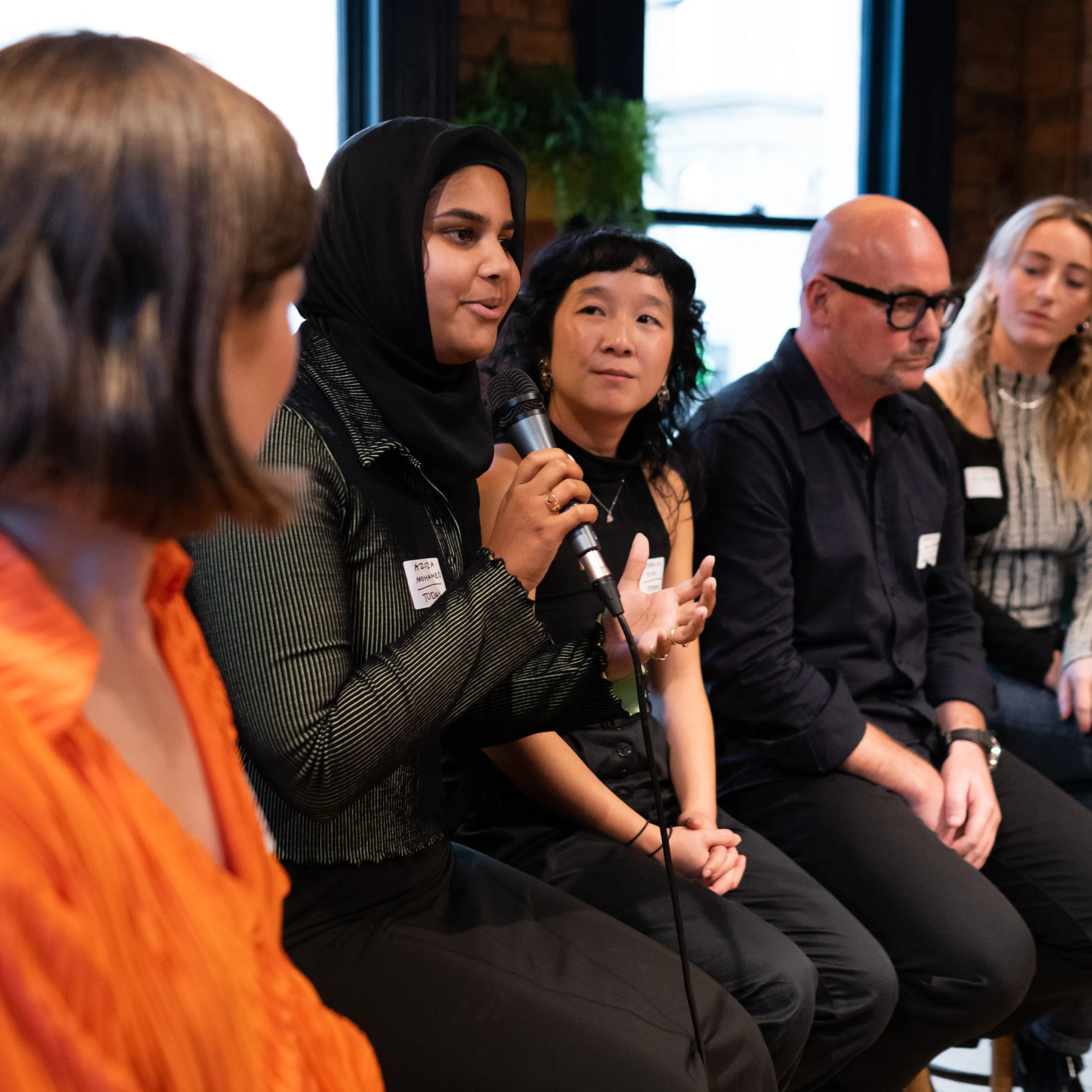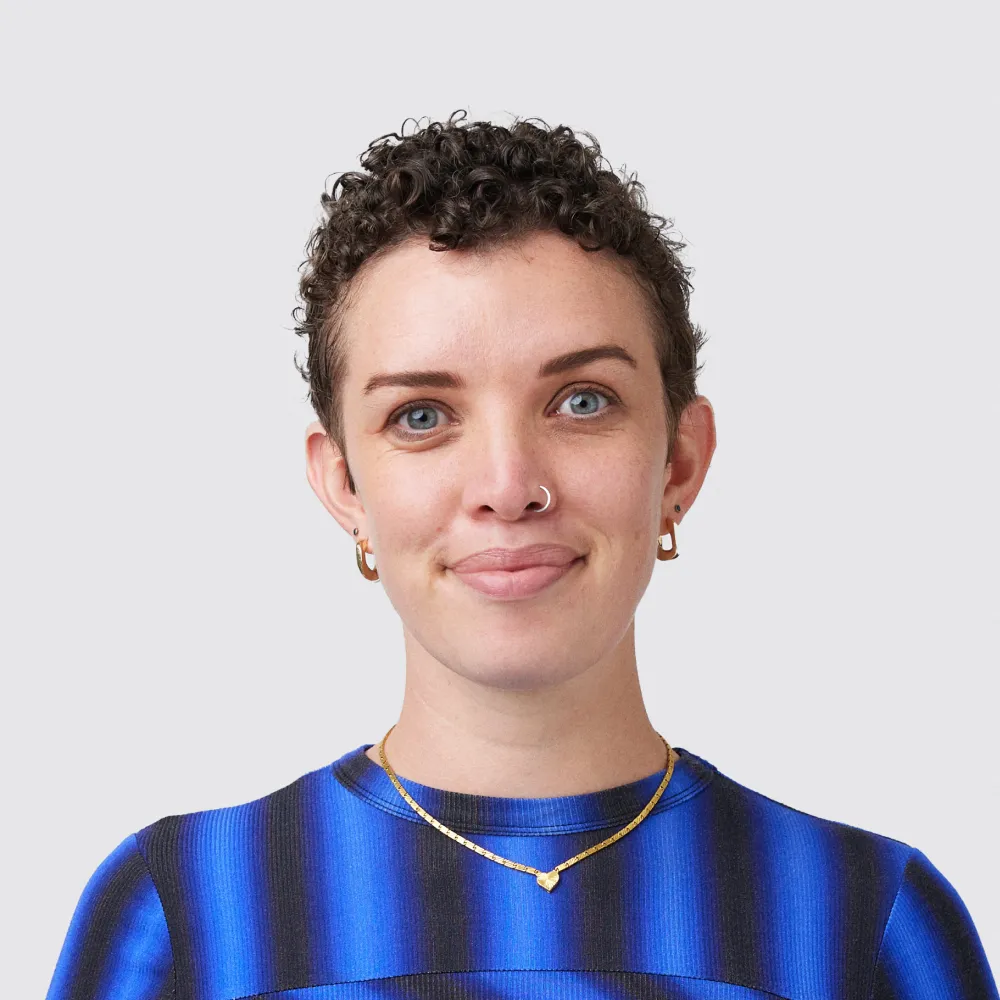Young people are our future, but haven’t had a voice in shaping it.
To inspire change, we brought together young people, designers, and change-makers to start the conversation.
Listen to our panel discussion with young people, designers and industry experts on the ins and outs of co-design and how you can confidently embrace unfiltered creativity.
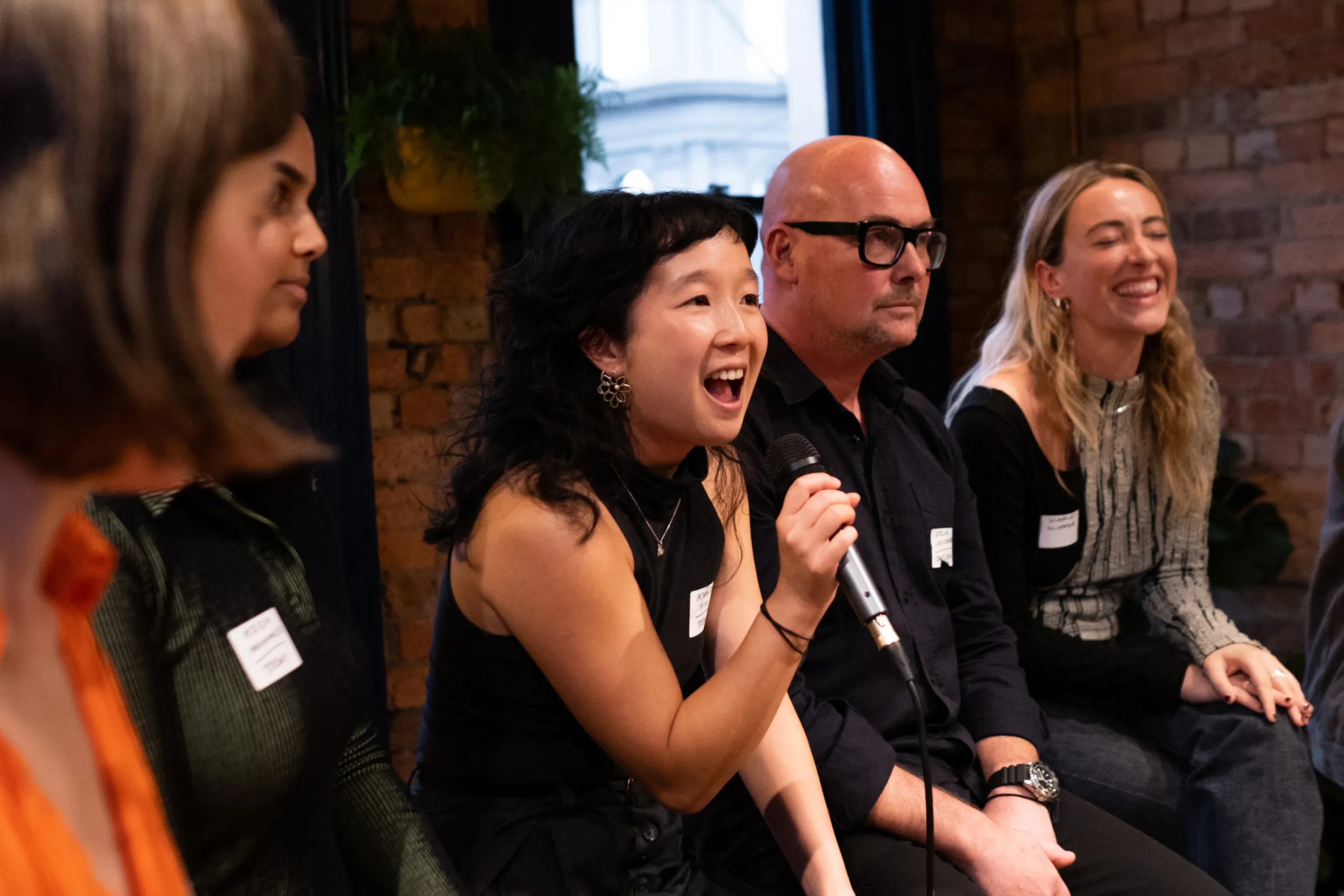
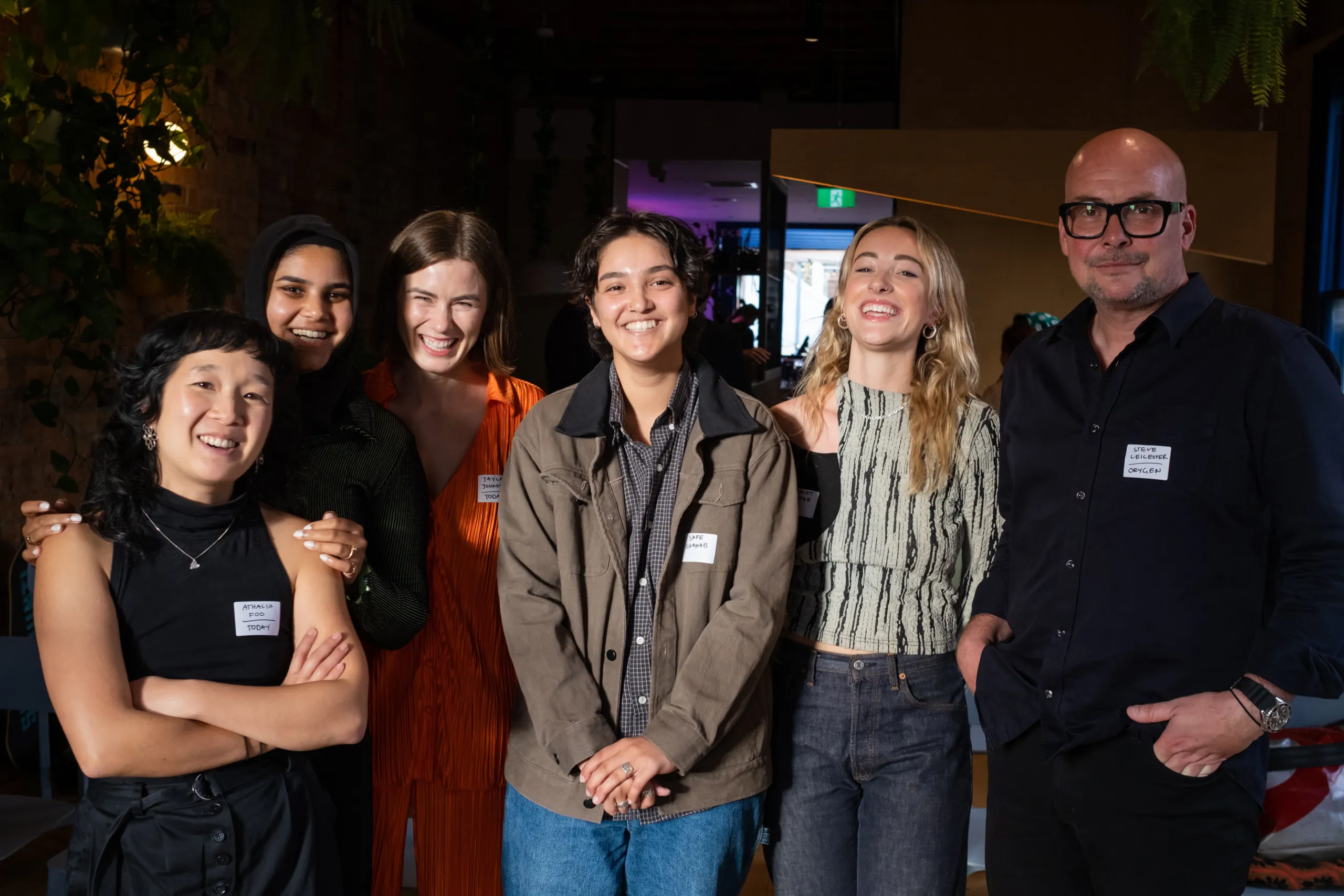
Athalia, Aziza, Tayla, Safe, Scarlet and Steve.
In conversation
Safe, Young Person, Youth Worker, Disability Advocate and Freelance Artist
Scarlet, Young Person, Student, and Intern at Alannah & Madeline Foundation
Steve Leicester, Clinical Psychologist
Aziza Mohamed, Content Design Lead at Today
Athalia Foo, Senior Content Designer at Today
Tayla Cooper, Studio Experience Manager
Tayla: My name's Tayla. I'll be hosting tonight's panel. We've got a ripper lineup for all of you. I am lucky enough to be the Studio Experience Manager at Today and part of that role is vibe and morale. So I hope that I can bring some of that tonight. It's gonna be a good one I feel. But I will let our panellists introduce themselves and tell us a bit about themselves. I'll start with you, Safe.
Safe: Hi, my name is Safe. My pronouns are he/him or they/them. I work as a youth worker, a disability advocate, and then a freelance artist, all around the place.
Scarlet: My name is Scarlet. My pronouns are she/her and I'm currently in my final year of my Bachelor of Arts and I’m working at the Alannah & Madeline Foundation (AMF) as an intern after having such a good experience working with Today and AMF in AMF’s first-ever co-design project around respectful relationships online.
Steve: Hi, I'm Steve Leicester. Pronouns he/him. Just to clarify, I'm not a young person. I'm a clinical psychologist and I've worked in the space of youth mental health for around 25 years now.
Foo: Hi, I'm Foo. I work at Today as a Content Experience Designer. My pronouns are she/her. I've been fortunate enough to work with a few of our clients in this room including Scarlet here to co-design some brilliant solutions.
Aziza: Hi, everyone. My name is Aziza. My pronouns are she/her. I’m also a Content Strategist at Today. And I've been working across a couple of the projects that were called out at the beginning. So The Gist, a sex education platform, and working with Nike to imagine a new more inclusive and equitable future of sport.
Tayla: Let's dive into this panel. My first question is for Scarlet, you lucky duck. Why should young people be at the front line of designing the future?
Scarlet: I think there are a few reasons why young people should be at the front line of designing the future. Firstly, because we are the ones that are gonna be dealing with the future and all of the challenges that it will present us. And I think it's great to get practice in solving those things now. And also we need to be able to have a say in things that are gonna affect us.
I think young people are the experts in the issues that they face. It doesn't really make sense to design programs or projects that have a target audience of young people and to not ask them what they feel and what they want and what is relevant for them.
I also think that young people provide a really great creative and sort of open and not so jaded perspective just because we're not as aware of all of the limitations of time and funding and a lot of things. And we're not so fearful, I think because we haven't had experiences in that field, which is really cool to bring a sort of an idealistic perspective. But it's really important to always be pushing the envelope and challenging thinking.
I think we always need to be keeping up to date and consulting with young people always. Because I'm 22, I'm a pretty young person, but for example, when I was in high school, we didn't even have tiktok and now tiktok is everything.
So you always need to be consulting with young people all the time. Things move so fast with technology especially.
Tayla: Awesome answer Scarlet. And that kind of launches into my question for you Safe. In your work as an activist and an advocate, what's been your experience of how young people and their ideas have been met by society and older people?
Safe: Thank you. It definitely kind of reiterates what Scarlet was saying.
I think that you'll find that young people are just so hopeful like you were saying, they're not jaded. I've been doing community organising in different activist spaces since I was about 15, 14.
And I think the general consensus of young people is that we're still so hopeful. I think a really common theme is that we will come up with all of these ideas for actions and protests and like different kind of campaigns. And a lot of the responses we were getting were neutral or positive from other older people that had hope.
But there was also a really kind of strong sense from a lot of older people that have done activism in the past and had had similar experiences that were just so jaded by, you know, fighting for things and not, not getting what they were after that, they kind of just were so not hopeful.
And so that meant that we would try to organise protests and we'd be like, yeah, we wanna get hundreds and thousands of people from across the whole world. And it's gonna be really great and a lot of adults will be like, “Look you’re doing great, but just so that you don't get your hopes up, you're gonna get really hurt, that's not gonna happen.”
And that was a really common sort of theme that we would come up against because, you know, these are older people that have been doing activism for 40 or 50 years longer than us. But because they've seen so much kind of lack of success, it means that they're kind of imposing that on us.
And we're young people. We're not that jaded. And so we were like, we're gonna try this anyway. We're gonna try and do a global protest.
And, you know, since then I think there's been hundreds of protests that have happened over the years where you've gotten like hundreds and thousands and millions of people striking from around the entire world.
I think that that just really goes to show young people are so hopeful, but the people that are in power, the ones that are older than us are so jaded that they don't have that hope and they are really quick to kind of impose that. It is a protective thing, they are trying to take care of us, but it's really disempowering when we actually know what we can achieve because we are young and we do have hope.
Tayla: It's incredible how young people have that ability to be mobilised so quickly. That sentiment of “we're just gonna try this anyway,” is something that I think we can all take a little bit of with us tonight. Ziz, you're up next, looking at the other side of that, you've worked with a lot of young people in co-design over the past year. What's different about that experience compared to working with other participants?
Aziza: Thanks Tay. I think one of the things that always strikes me about young people whenever I work with them—whenever we're on a project—is that hopefulness and that optimism.
I think of how readily they bring that mindset to create, and think about the future, and get involved, and start imagining, it just comes so naturally to younger people. It's not like pulling teeth with some participants where they're like, “what do you mean I have to draw something or create a storyboard?”
Young people are really primed with that creative mindset.
The other thing is especially when we're talking about imagining brighter futures—10 years for your eye might seem like, you know, that's not a lot of time, but for a young person even just thinking to 2030 that's a whole different world that might be more than half my life away in terms of what could be possible and how bold and creative we can be with our ideas.
So it really brings this unique mindset. And then at the same time, they don't treat the answers like they're far away. There's this strong action bias, “we're acting like the future's already here, we can take action now.”
And that's the dichotomy that they have around the future: There's so much possibility, but I don't get why we're not starting right now, let's do it. There's no constraint. That always impresses me every time.
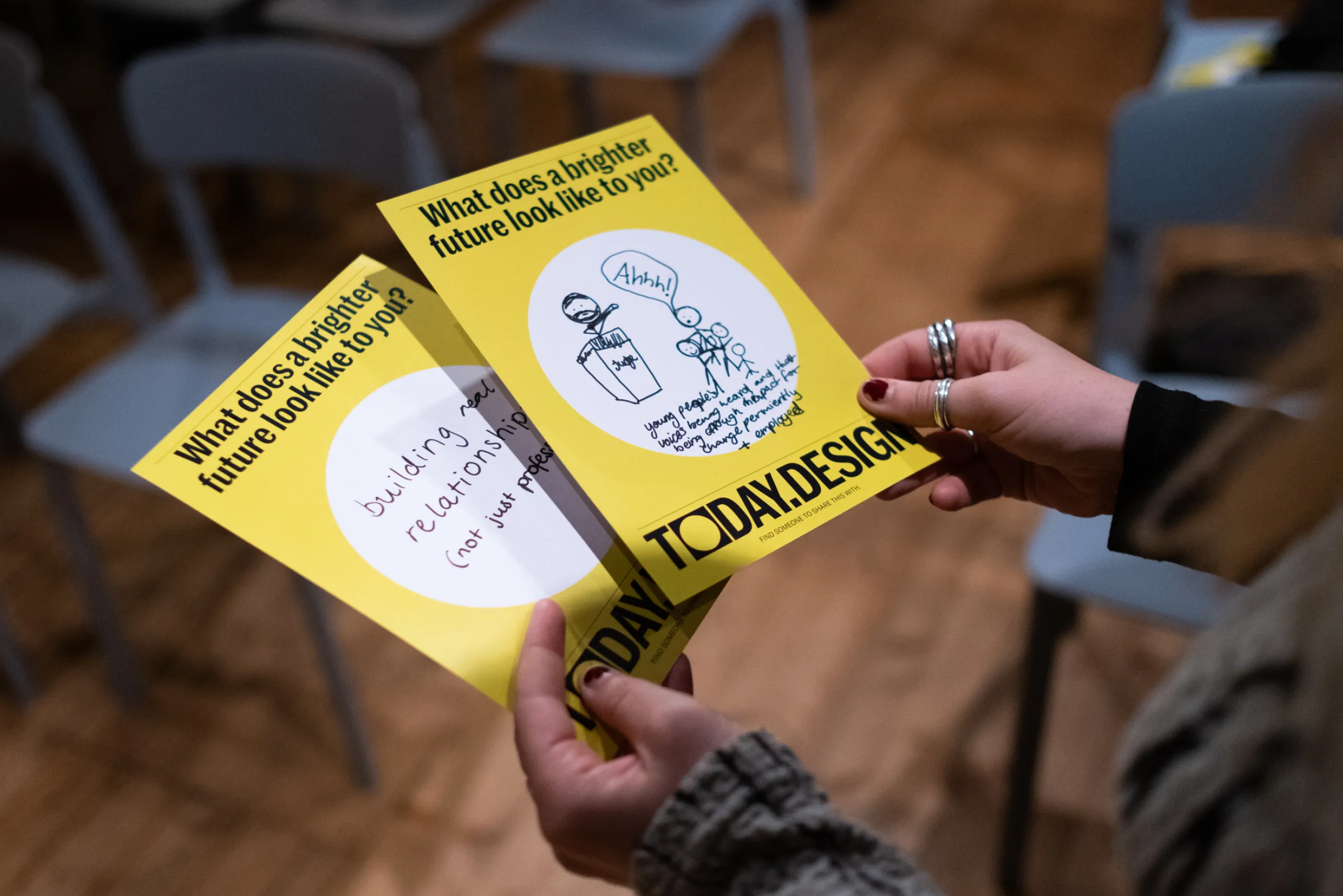
Tayla: Thanks Ziz. And on to Steve. So you've worked in the mental health sector for quite a while. Why do you think that young people—with all this boundless energy and hopefulness and readiness for action—why have they been so largely left out of design in this space until now and in other spaces as well?
Steve: I think there's a couple of things. First of all, it's not excusable that they have been left out. But I will say a couple of things. I conceptualise mental health services way beyond the waiting lists at private practices or public mental health services. The foundation of all good mental health, I think, and all good treatments in mental health, actually come down to two things, meaningful connection and purpose: “I'm doing something that aligns with my values and takes me beyond the present.” No matter what podcast you listen to, they're lying if they don't say those two things.
So if we take the more lateral approach and say examples where young people have been finding ways to bring each other together in meaningful ways, to share purpose, when they're not sure of purpose, to encourage, I think we can find examples of that all over the place. But we have to look beyond the current very conservative systems.
So it has been there but not where it should be in the big systems. But there's another premise as well. Please don't make the assumption that health services are designed at all. And that's actually the bigger worry, health services are funded, they're not necessarily designed.
So if we have examples like you would be part of and leading, that's actually where change can occur. But I think the great misgiving is that there is a complete lack of design and the bit of design that you're tapping into which I think is the ultimate, is the concept of hope and optimism. If that can be projected—it's the reason I've stayed in this industry for 25 years—because hope and optimism are the essence of working within this space.
I think the bigger issue is, unfortunately, that health services aren't designed.
Tayla: That segues perfectly into my question for Foo, Steve. Why do you think creativity and creating and making in co-design is so important?
Foo: Great question, Tay. I think that everyone's touched on bits and pieces of this. I think creativity is one of those things that helps us unlock. We'll look past our biases, past the things that hold us back, to imagine a possibility in the future.
And particularly when you're doing it with young people, there's that un-jadedness, there's that tenacity, there's that, “why not?” I think that that's the thing that really comes with creativity, particularly when you’re engaging with young people.
We use techniques like prototyping and that kind of thing to help kind of put parameters or a frame around something that allows people to kind of dream big, to help us develop something and create something together that we might be able to take forward. That's the beauty of creativity, to imagine something outside of the bounds that you do know and to bring that authenticity of yourself, your views, and your experiences into a solution.
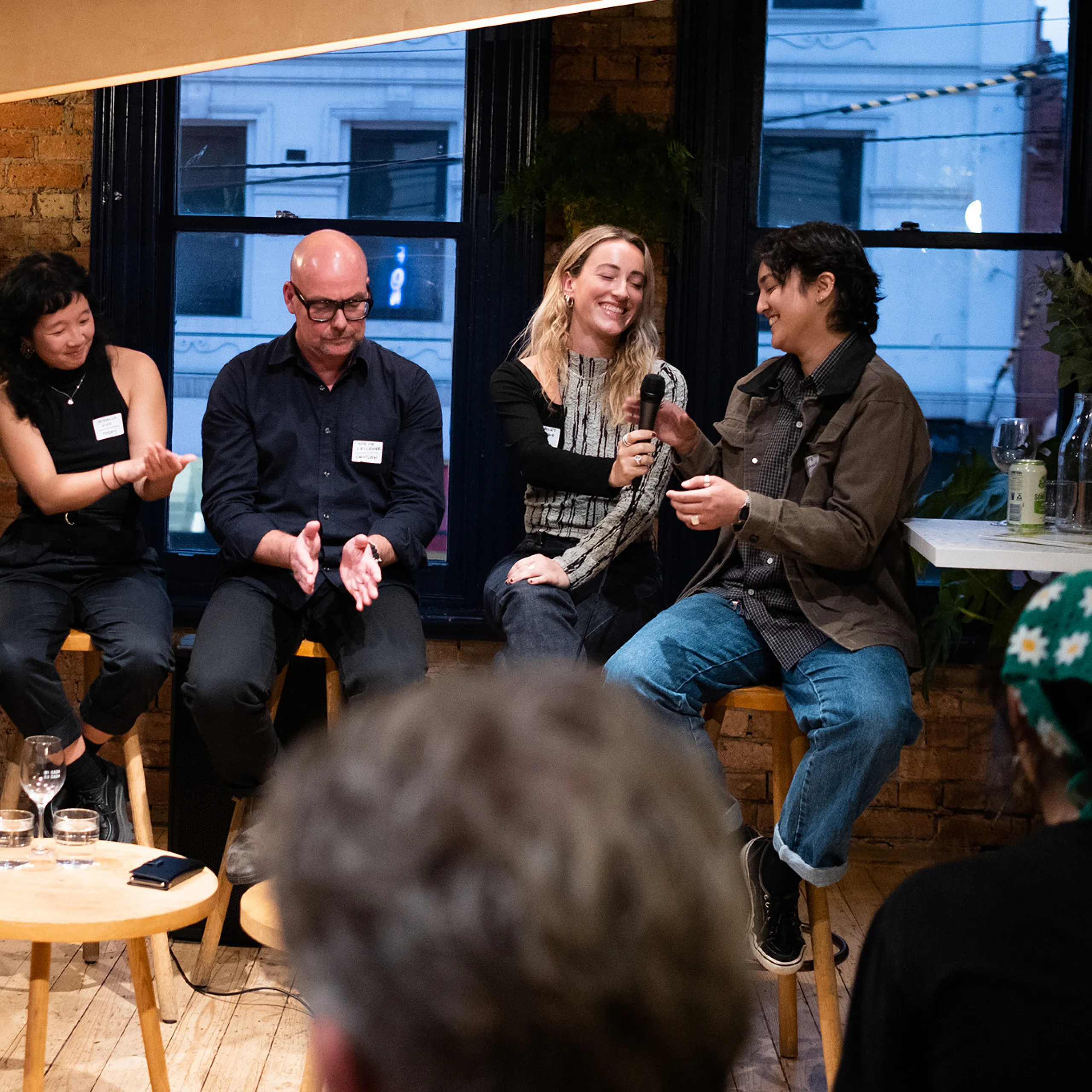
Tayla: Safe, how do you understand what creativity is? How do we allow space for people to express themselves individually and as individuals?
Safe: So for me, creativity is a natural part of communication. And relating to that, creativity is an integral part of communication, particularly for young people of intersecting identities.
So I am a queer, disabled, trans person of colour—a whole mouthful. And then as one of my jobs, I'm a youth worker for that very same population. Something that you'll notice when you're working with young people, particularly young people that come from other marginalised communities, is that there are gonna be so many communication barriers. But when you try to integrate creativity into the mix, communication becomes a lot more universal.
So for me, when I'm working with disabled young people specifically, one of the exercises that I work in teaching disabled young people when they're doing a program about advocacy and leadership, is about developing a communication style that works for you.
We live in a particularly able-bodied society in which the most that we see communication is an email, a text, a voice recorded message, speaking on panels up here, having conversations etc. And while these are really, really important, they're not accessible for everyone.
And I think that when you kind of play creativity into communication, that's when you'll be hearing from the most diverse voices. So in one of the exercises that I was talking about, we teach young people what communication style works for them. We go beyond just the barriers of regular communication styles. We can let disabled young people dance, or sing, or draw comics. It's about, “how are you going to communicate, not in a way that works for other people, but works for you.”
That's when you're hearing the most authentic voices.
So for me, creativity is just a very natural and integral part of communication and how we can make communication as a whole more inclusive and accessible for everyone, particularly marginalised people.
Tayla: Next question is for Scarlet. From your experience being involved in co-design for the Crushed But Okay project, what sort of conditions are needed for young people to harness their creativity?
Scarlet: I think creating an environment that is not your typical professional kind of context is really important when working with young people because we have never had experience in working in these professional environments.
So it can be really intimidating and it's really alienating for people that maybe aren't confident or don't feel like they're succeeding in school, [because] they're not thriving in school, [or] they're not academic.
Young people are always fed this narrative of, “you're not developed and you're still learning things, you're not good enough, your opinions aren't as valuable as older people who have had this much experience working in this field, or have this much knowledge and this many degrees.”
And so really breaking down that traditional style of working is really important and really diminishing the power and balance is I think is really key. This is done through trust building, and rapport building, and relationships. Making time for the fun and silly conversations, in a very casual environment. You sort of need to approach it more as if you're trying to be friends with these young people, not be in a working relationship.
That's something that Foo and Molly and Dan did so amazingly in the project that I worked on and it's not only important so we can feel comfortable to share our big ideas and harness our creativity and not feel like we'll be judged or that they'll be shut down. But it's also so important for feeling comfortable to give feedback, which is obviously a really integral part of co-design. We're co-designing something, we're not just giving our opinions and then adults are going away and designing it. We have a say in the final product as well.
To be able to feel comfortable to give an older person—who has more experience than you—feedback and criticism is scary. I think that's why it's so important to build those relationships.
Foo: Just to add to that. I was fortunate enough to work with the Alannah & Madeline Foundation for two projects and Scarlet was on the second project. It was so nice to hear them tell us that we were wrong and the product that we created, the thing that we came out with, would have been so bad if they hadn't said “absolutely not, that is incorrect.” You know, we wouldn't have known that otherwise. So, thank you.
Tayla: Thanks, Foo. And Ziz, how do you go about setting these spaces up to co-design with young participants? How do you feel about making those spaces the right way to let their creativity shine through and let them feel comfortable to be able to give that kind of feedback?
Aziza: I think Scarlet, you've said a bunch of the right words already. It's about building that trust, that sense of safety, that sense of confidence in young people to feel like they can meaningfully contribute and that everybody's voice is valued.
But I think also that sense of authenticity that young people bring, how do we make sure that isn't lost in translation as we move from a co-design process through to something that's being created, being launched, being sent out.
And I think that all comes from setting up the right conditions for that to thrive and that connection to be really created between the young people and people with lived experience. Sometimes clients, sometimes us as facilitators all having to, you know, hopefully distribute that power dynamic as we as we try to set that group up for success. It's all about working together at the beginning of a co-design process to work out, what are our principles? What do we want to achieve through this process? What are the non-negotiables? How do we want to work together and what are the expectations around how I can contribute and how I can be part of this?
So I think doing a lot of that team forming at the beginning is so important. But I think along the way, it's about defining that together, what are the right ways to come together and work things out.
When we were working with 24 young women, and non-binary people at the peak of Melbourne's lockdown on an online remote-only co-design, in addition to responding to design briefs, we were also getting people to respond to a movement challenge, do some physical activity every day that you're responding to this brief. We had kids that, you know, were really quiet on day one, were suddenly the loudest and most active contributors in that co-design just by finding other ways to connect with people. That isn't just, here's a task, respond to it. Let's evolve, let's do things differently if that's what the situation calls for.
Tayla: So yeah, kind of going back to what Safe was saying about letting them be creative in their own way and that kind of becomes a form of language and how you can communicate. Foo, how do you strike the balance in co-design with possibility and this incredible thing that young people bring to the table with deliverables and what can actually be achieved? How do you strike that balance?
Foo: That's a great question, Tay. So it kind of comes back to something that Ziz was saying. It’s about coming back to, “What is it that we're really trying to achieve?” And being able to be flexible about hearing from young people about what they need.
So, you know, you might go into something and be like, the thing that we want is a campaign.
But actually, when you co-design with young people, what they want is not necessarily a campaign, they want a community. We don't wanna kind of hamper those big ideas, we don't wanna say “no, that's too big, you're thinking too big.” My background originally, before coming to Today was very much in the comms marketing side of things, so you’ve got to know your audience. It's fundamental. But I can't know my audience because I'm not my audience, I'm working with my audience and they're gonna tell me, “Hey, I want this.”
So it's about, I guess, two expert groups, our co-designers, our young people, our subject matters experts. And then us, the co-design facilitators. It's our job to listen to, hear the crux of what you need, of what you want. And then think about what the client is able to offer and what's possible in that realm, and take that crux and push that forward to make sure that the voice, the needs, is not lost in what we end up producing.
We're really fortunate to work with a bunch of clients who really trust the process, really invest in the process, and that couldn't be possible without that and the investment from young people like Safe and Scarlet as well.
Tayla: Question for you, Steve. Steve, what advice would you give to organisations on what to do or what not to do to be inclusive of young people and their ideas? How do you put all this into practice in your realm?
Steve: I think there are a couple of aspects. One is that yes, there is an element of change, not specifically within health industries, of an expectation of A: co-design being mentioned more. I don't think it's being defined well, and I don't necessarily think it's being practised well, but certainly, within some contracts, you're seeing it more and more compared to five years ago. So there's some context.
Don't sacrifice yourself to organisations where the values aren't firmly bedded. A few tips: look to see if there are young people involved in their board, in their executive. It's worth taking a little bit of a basic business approach and looking at the previous year business statements and so forth and reports to see if anything related to co-design involving young people in what matters is even mentioned.
So I think choose your targets. I'm not saying don't invest energy in completely green fields but be mindful. I think also don't go in alone, particularly if you're entering an organisation or a project that looks great but is saying “Oh, we just want a single young person.” That's never good practice in any context and shouldn't be allowed. So I think having some accountability for the organisations is really important in how you choose your targets.
Starting small is really important. And I don't mean diminishing hope or diminishing dreams but really aiming for areas that think, “Look that worked and the sky didn't fall in.”
And there's another thing, Scarlet, you mentioned, which is very true.
And I can't imagine what it's like being at a round table of old people. It can be scary.
But I'll tell you one thing, an old wanker being called a dickhead by a colleague is nothing compared to how powerful it is being called a dickhead by a key stakeholder, a young person in there. It's not for me to tell you the power and gravitas you have, but my next sentence is gonna sound like I'm going to. I hope in some way you can believe the respect that you have in the room.
I haven't answered the question though. I think the how, is to understand the context you're walking into, it's an expectation if young people are being affected by whatever context the organisation is working in. But do look after yourself and, pick the targets.
I think the other thing is an expectation of hope and optimism, which you're saying very loudly here is a really big thing. I'll say what blocks organisations from doing it is pride and fear. You’ve gotta let go of that pride, which is harder the older you get. But unless you do, you're not free to think, you're not free to be creative, and you're certainly not free to listen. So that investment needs to be made.
Tayla: You did answer the question and I think, dare I say, offered some sage advice to look after yourself because it can be a lot of labour to, you know, go in there and be that brave inspiring young voice.
Steve: Just to clarify, sitting in the seat as a professional, I can come from a professional experience. So I've got a nice guard and filter there. You're coming from a personal experience, it's not filtered. I can put on a bit of a show here and so forth or be Steve the psychologist. I walk out and I don't have to be Steve the Psychologist.
You all carry it completely.
So this thing that the personal tax it can take on you should not be underestimated and really, really don't go into any of those things on your own.
Tayla: Thank you. I would love to end with our incredible young people here. Scarlet and Safe, if we were all to leave here tonight with one thing, what would you want it to be?
Scarlet: I think the biggest thing that I would want you to leave with is that—Steve you sort of just touched on this. It does require letting go of control and some pride and fear, which is obviously so hard for anyone to do, but especially people that have been working in an industry or in a field for so long and then these young people come in who have never, you know, who haven't had that same trajectory yet. So it is really scary but it can't be a co-design process without doing that. Otherwise, it is just a consultation and it's sort of like, “oh yeah, we want to hear from you. Oh, actually, but we don't really like that idea of what you're saying. So sorry, we're actually just gonna still do this.”
That is not codesign.
So I think, yeah, if you're not willing to let go of that control, then it's maybe that's, it's not something that an organisation is ready for yet. And it also feels really disempowering to be asked to give your opinion and then to be sort of ignored. And I think another really amazing thing about co-design is the empowerment that it gives young people.
Safe: So we talked a lot about the importance of young voices. And if I was telling any of you with like some last little bits of Safe wisdom, it would be yes, listen to young voices, but think about the young people that you're interacting with and make sure that that is diverse and make sure that that is intersectional and there is a lot of representation in that. You can put so much work into collaborating with young people to design services to improve the world but if you are only working with the majority population, there are going to be so many vulnerable people trying to access services, trying to walk around into the world, and it's not gonna be made or designed for them.
So think about the reach that your work is having, think about how you can integrate more inclusivity into your practices. And make sure that the young people you're working with are actually representative of the world.
